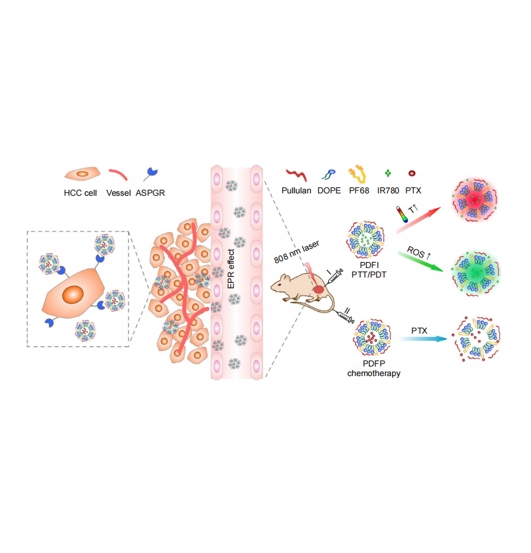文献:
Pullulan-coated phospholipid and Pluronic F68 complex nanoparticles for carrying Ir780 and paclitaxel to treat hepatocellular carcinoma by combining photothermal therapy/photodynamic therapy and chemotherapy
文献链接:
https://pubmed.ncbi.nlm.nih.gov/29255359/作者:
Dan Wang,sipei Zhang,Tao Zhang, guoyun Wan,Bowei chen, Qingqing Xiong, Jie Zhang, Wenxue Zhang, Yinsong Wang
相关产品:
原文摘要:
IR780, a near-infrared dye, can also be used as a photosensitizer both for photothermal therapy (PTT) and photodynamic therapy (PDT). In this study, we designed a simple but effective nanoparticle system for carrying IR780 and paclitaxel, thus hoping to combine PTT/PDT and chemotherapy to treat hepatocellular carcinoma (HCC). This nanosystem, named PDF nanoparticles, consisted of phospholipid/Pluronic F68 complex nanocores and pullulan shells. IR780 and paclitaxel were loaded separately into PDF nanoparticles to form PDFI and PDFP nanoparticles, which had regular sphere shapes and relatively small sizes. Upon near-infrared laser irradiation at 808 nm, PDFI nanoparticles showed strong PTT/PDT efficacy both in vitro and in vivo. In MHCC-97H cells, the combined treatment of PDFI nanoparticles/laser irradiation and PDFP nanoparticles exhibited significant synergistic effects on inhibiting cell proliferation and inducing cell apoptosis and cell cycle arrest at G2/M phase. In MHCC-97H tumor-bearing mice, PDFI nanoparticles exhibited excellent HCC-targeting and accumulating capability after intravenous injection. Furthermore, the combined treatment of PDFI nanoparticles/laser irradiation and PDFP nanoparticles also effectively inhibited the tumor growth and the tumor angiogenesis in MHCC-97H tumor-bearing mice. In summary, we put forward a therapeutic strategy for HCC treatment by combining PTT/PDT and chemotherapy.
DOPE(1,2-二油酰-SN-甘油-3-磷酰乙醇胺)是一种磷脂。它的化学结构主要由甘油骨架、两个油酰(oleoyl)脂肪酸链、磷酸基团和乙醇胺头部基团组成。在水中,DOPE 可以形成脂质体等多种脂质结构。脂质体是一种人工制造的球形小囊泡,由磷脂双层组成,内部包裹着水溶液。DOPE 由于其特殊的化学结构,有助于稳定脂质体的结构。它的熔点相对较低,这与其脂肪酸链的不饱和程度有关。该文献基于DOPE的相关性质,PDF纳米颗粒合成如下:

图:反应机制
空白PDF纳米颗粒的制备及表征:
将DOPE 和PF68溶于氯仿中,并在室温下连续搅拌。接下来,将混合物减压蒸发,形成薄膜,并在真空干燥器中进一步干燥过夜,以除去剩余的溶剂。然后,将干膜在超声波清洗器中的去离子水中水合,然后通过聚碳酸酯过滤器,得到DF纳米芯。然后将普鲁兰核与DF纳米核以不同重量比搅拌孵育,得到PDF纳米颗粒。所有实验步骤都通过严格避光进行。使用仪器测量了DF纳米核和PDF纳米颗粒的尺寸、尺寸分布和Zeta电位。用透射电子显微镜对其形态进行了表征。此外,通过监测磷酸盐缓冲盐溶液(PBS)中的大小和zeta电位变化,评估PDF纳米颗粒的体外稳定性。
PDFI和PDFP纳米颗粒的制备和表征:
IR780-和PTX-负载的DF纳米核,分别称为DFI和DFP纳米核,首先使用前面所述的薄膜水化方法制备。将IR780或PTX与DOPE/PF68在氯仿中以不同比例的氯仿混合,然后干燥形成含化合物的薄膜。然后,这些薄膜在去离子水中水合,然后通过聚碳酸酯过滤器形成DFI或DFP纳米核。随后,将普鲁兰糖与这些纳米核以一定的重量比孵育,从而得到PDFI或PDFP纳米颗粒。测定纳米核和纳米颗粒的尺寸、尺寸分布和zeta电位,同时通过检测其在4°C条件下储存3 d的尺寸变化来评估其在10% FBS中的体外稳定性。此外,用透射电镜对PDFI和PDFP纳米粒子的形貌进行了表征。

图:电子显微镜图像
结论:
该文献成功制备了基于DOPE合成的PDF纳米颗粒。实验数据表明,在MHCC-97H细胞中,PDFI纳米颗粒/激光照射和PDFP纳米颗粒联合处理对抑制细胞增殖、诱导细胞Apoptosis 和细胞周期阻滞在G2/M期具有协同作用。此外,PDFI纳米颗粒/激光照射联合PDFP纳米颗粒也能有效抑制MHCC-97H荷tumour小鼠的tumour生长和tumourBlood vessels生成。

 2024-12-19 作者:ws 来源:
2024-12-19 作者:ws 来源:

